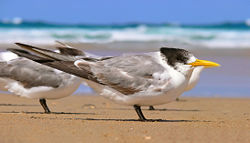Tern
2008/9 Schools Wikipedia Selection. Related subjects: Birds
| Terns | ||||||||||||
|---|---|---|---|---|---|---|---|---|---|---|---|---|
 Crested Tern.
|
||||||||||||
| Scientific classification | ||||||||||||
|
||||||||||||
| Genera | ||||||||||||
|
Terns are seabirds in the family Sternidae, previously considered a subfamily (Sterninae) of the gull family Laridae (van Tuinen et al., 2004). They form a lineage with the gulls and skimmers which in turn is related to skuas and auks. Terns have a worldwide distribution.
Most terns were formerly treated as belonging into one large genus Sterna, with the other genera being small, but analysis of DNA sequences supports the splitting of Sterna into several smaller genera (see list, below) (del Hoyo et al., 1996; Bridge et al. 2005; Collinson 2006).
Many terns breeding in temperate zones are long-distance migrants, and the Arctic Tern probably sees more daylight than any other creature, since it migrates from its northern breeding grounds to Antarctic waters. One Arctic Tern, ringed as a chick (not yet able to fly) on the Farne Islands off the Northumberland coast in eastern Great Britain in summer 1982, reached Melbourne, Australia in October 1982, a sea journey of over 22,000 km (14,000 statute miles) in just three months from fledging—an average of over 240 km per day, and one of the longest journeys ever recorded for a bird.
They are in general medium to large birds, typically with grey or white plumage, often with black markings on the head. They have longish bills and webbed feet. They are lighter bodied and more streamlined than gulls, and look elegant in flight with long tails and long narrow wings. Terns in the genus Sterna have deeply forked tails, those in Chlidonias and Larosterna shallowly forked tails, while the noddies (genera Anous, Procelsterna, Gygis) have unusual 'notched wedge' shaped tails, the longest tail feathers being the middle-outer, not the central nor the outermost. Terns ranges in size from the Least Tern, at 42 g (1.5 oz) and 23 cm (9 inches), to the Caspian Tern, at 630 g (1.4 lbs) and 53 cm (21 inches).
Most terns (Sterna and the noddies) hunt fish by diving, often hovering first, but the marsh terns (Chlidonias) pick insects of the surface of fresh water. Terns only glide infrequently; a few species, notably Sooty Tern, will soar high above the sea. Apart from bathing, they only rarely swim, despite having webbed feet.
Terns are generally long-lived birds, with several species now known to live in excess of 25-30 years.
Classification and species list
A recent study (Thomas et al., 2004) of part of the cyt b gene sequence found a closer relationship between terns and the Thinocori, some species of aberrant waders. These results are in disagreement with other molecular and morphological studies (see Paton & Baker, 2006) and are best interpreted to prove an extraordinary amount of molecular convergent evolution between the terns and these waders, or as retention of an ancient genotype.
According the mtDNA studies and review by Bridge et al (2005), the genera and species of terns are as follows:
- Genera Anous, Procelsterna, Gygis - noddies. A tropical group, characterised by the notch-wedge shaped (not forked) tail; coastal and pelagic oceanic.
- Brown Noddy Anous stolidus
- Black Noddy Anous minutus
- Lesser Noddy Anous tenuirostris
- Blue Noddy Procelsterna cerulea
- Grey Noddy Procelsterna albivitta
- White Tern Gygis alba
- Little White Tern Gygis microrhyncha
- Genus Onychoprion - "brown-backed" terns
- Grey-backed Tern Onychoprion lunata
- Bridled Tern Onychoprion anaethetus
- Sooty Tern Onychoprion fuscata
- Aleutian Tern Onychoprion aleutica
- Genus Sternula - little white terns
- Fairy Tern Sternula nereis
- Damara Tern Sternula balaenarum
- Little Tern Sternula albifrons
- Saunders's Tern Sternula saundersi (formerly considered a subspecies of Little Tern)
- Least Tern Sternula antillarum (formerly considered a subspecies of Little Tern)
- Yellow-billed Tern Sternula superciliaris
- Peruvian Tern Sternula lorata
- Genus Phaetusa - Large-billed Tern
- Large-billed Tern Phaetusa simplex
- Genus Hydroprogne - Caspian Tern
- Caspian Tern Hydroprogne caspia
- Genus Gelochelidon - Gull-billed Tern
- Gull-billed Tern Gelochelidon nilotica
- Genus Larosterna - Inca Tern
- Inca Tern Larosterna inca
- Genus Chlidonias - marsh terns
- Black Tern Chlidonias niger
- White-winged Tern or White-winged Black Tern Chlidonias leucopterus
- Whiskered Tern Chlidonias hybridus
- Black-fronted Tern Chlidonias albostriatus (ex-Sterna albostriata)
- Genus Thalasseus - crested terns
- Lesser Crested Tern Thalasseus bengalensis
- Royal Tern Thalasseus maximus
- Greater Crested Tern or Swift Tern, Thalasseus bergii
- Chinese Crested Tern Thalasseus bernsteini
- Elegant Tern Thalasseus elegans
- Sandwich Tern Thalasseus sandvicensis
- Genus Sterna - large white terns
- Forster's Tern Sterna forsteri
- Trudeau's Tern Sterna trudeaui
- Common Tern Sterna hirundo
- Roseate Tern Sterna dougallii
- White-fronted Tern Sterna striata
- Black-naped Tern Sterna sumatrana
- South American Tern Sterna hirundinacea
- Antarctic Tern Sterna vittata
- Kerguelen Tern Sterna virgata
- Arctic Tern Sterna paradisaea
- River Tern Sterna aurantia
- Black-bellied Tern Sterna acuticauda (possibly Chlidonias)
- White-cheeked Tern Sterna repressa (possibly Chlidonias)